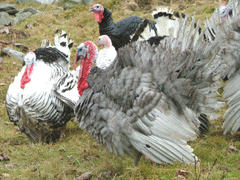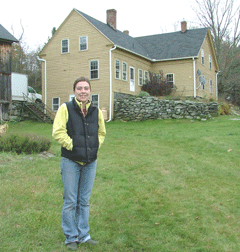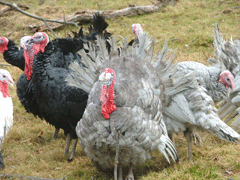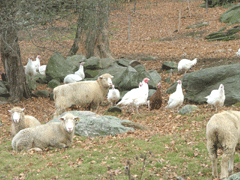Tradition Revived
Air Date: Week of November 21, 2008

A Blue Slate tom turkey struts his stuff. (Photo: Marc Renaghan)
Almost all of the turkeys eaten in the United States are the same species: the Broad-Breasted White. But as Living on Earth’s Bobby Bascomb reports, heritage breeds of turkeys, like the Bourbon Red and Blue Slate, are making a comeback.
Transcript
GELLERMAN: Around this time of year the turkey reluctantly takes its place of honor on dinner tables across the nation. Just trot down to your local store and you’ll find that 99 percent of the birds ready for roasting are the same breed: the broad-breasted white.
That’s certainly not the kind the pilgrims may have feasted on that first Thanksgiving so long ago. But today, ancient varieties of turkey are making a comeback. People are increasingly flocking to the old turkey taste, as Living on Earth’s Bobby Bascomb discovered down on a Massachusetts farm.
[TURKEYS GOBBLING, WALKING SOUNDS]
BASCOMB: Kate Stillman runs a family farm. Behind her mustard-colored farm house small fields bordered by stone walls are dotted with sheep and turkeys. But these are no ordinary turkeys.
[MORE GOBBLING AND WALKING]

Kate Stillman is a farmer in Hardwick, Massachusetts. (Photo: Bobby Bascomb)
STILLMAN: If you look at the heritage turkeys, their heads are beautiful. These are blue slates that we’re looking at. And most of their head is this iridescent, light sky blue color with a red neck. And, I mean, the colors are fantastic, but they’re very reptile looking.
[GOBBLING]
BASCOMB: Kate and her husband Aidan raised 50 heritage turkeys this year. They also raised about 200 of the more conventional white turkeys.
STILLMAN: If you take a look at the white ones versus, you know, the colored ones are the heritage ones. And you can see there is a difference with their build and how they look.

A Blue Slate tom turkey struts his stuff. (Photo: Marc Renaghan)
[GOBBLING]
STILLMAN: The heritage ones are – well they look like they don’t have that big a breast, you know, they’re a little leaner, slimmer birds.
BASCOMB: But a trim turkey with a small breast isn’t what most people want on their Thanksgiving table.
SMITH: For whatever reason, Americans love the breast and the white meat.
BASCOMB: Andrew Smith is a turkey historian. He wrote the book on turkeys, literally. His book “Turkey: An American Tale” traces the history of our favorite fowl. The first European explorers took wild American turkeys back to Europe, where breeders started to raise them – for their feathers.
SMITH: And that’s the name of black and white and bourbon red and buff and slate, etc. The exception to that, of course, was the bronze turkey, which was the largest heritage breed, and had the largest breast.

Where did its face go? Many species of heirloom turkeys have brightly colored wrinkly skin. (Photo: Marc Renaghan)
BASCOMB: That broad breasted bronze was crossed with the Holland white to create the turkey we know today – the broad breasted white. Seventy-three million of them will be eaten over the holidays. Smith says most of them are raised on factory farms.
SMITH: They’ve had their toes snipped off a few days after their birth. They’ve had their beaks snipped off in order to prevent turkeys from attacking each other, which they do in confined spaces.
BASCOMB: Milton Madison, senior agricultural economist at the USDA says most turkeys are kept in big barns. As for removing beaks and toes, he describes it as more of a turkey pedicure.
MADISON: At times, the toes and beaks will be trimmed slightly so that they’re a little more blunt, similar to trimming your finger nails so that you don’t scratch yourself or others around you.
[GOBBLING]
BASCOMB: Raising free range, heirloom turkeys is more expensive than mass producing them. They cost three times as much to buy as babies, and it takes several months longer to mature. A heritage turkey from the Stillmans will cost a hundred dollars. Compared with about sixty for the traditional birds. But people are willing to pay. Don Schrider of the American Livestock Breeds Conservancy says that’s going to help save these birds from extinction.

Turkey and sheep are pastured together at the Stillman turkey farm. Turkeys eat insects that would otherwise bother the sheep. (Photo: Bobby Bascomb)
SCHRIDER: If people eat heritage turkeys, then more breeding stock is maintained, and then the next season more heritage turkeys can be produced and it actually gives them a job and the population grows.
BASCOMB: The number of heirloom birds has increased eightfold in the last ten years. Farmer Kate says people like the taste of the old-fashioned birds.
[GOBBLING]
STILLMAN: The heritage birds have a higher percentage of dark meat which for dark meat lovers - and that’s usually the more flavorful part of the turkey – almost everybody who ordered a turkey from us last year has ordered two turkeys. So I don’t know whether they’re thinking they’re going to pop one in the freezer and keep it for Christmas or something like that, but people raved about the turkeys.
[GOBBLING]
BASCOMB: The demand’s been so great this year that that Stillmans actually ran out of heirloom birds.
STILLMAN: You know I had somebody call me this morning and she said to me, oh please Kate, you know, can we get a turkey from you. We’ve been away and I really wanted to call. And she’s a really good customer. We were supposed to be saving two turkeys for my aunt for Thanksgiving and I called my mother and I’m like, well, you guys are only getting one turkey ‘cause I really couldn’t say no to her. [Laughing]
BASCOMB: And so, come Thursday, the Stillmans might go without a heritage turkey at the center of their table. But they’ll have made a lot of Massachusetts families very happy.
For Living on Earth, I’m Bobby Bascomb.
Links
The National Turkey Federation
Living on Earth wants to hear from you!
Living on Earth
62 Calef Highway, Suite 212
Lee, NH 03861
Telephone: 617-287-4121
E-mail: comments@loe.org
Newsletter [Click here]
Donate to Living on Earth!
Living on Earth is an independent media program and relies entirely on contributions from listeners and institutions supporting public service. Please donate now to preserve an independent environmental voice.
NewsletterLiving on Earth offers a weekly delivery of the show's rundown to your mailbox. Sign up for our newsletter today!
 Sailors For The Sea: Be the change you want to sea.
Sailors For The Sea: Be the change you want to sea.
 The Grantham Foundation for the Protection of the Environment: Committed to protecting and improving the health of the global environment.
The Grantham Foundation for the Protection of the Environment: Committed to protecting and improving the health of the global environment.
 Contribute to Living on Earth and receive, as our gift to you, an archival print of one of Mark Seth Lender's extraordinary wildlife photographs. Follow the link to see Mark's current collection of photographs.
Contribute to Living on Earth and receive, as our gift to you, an archival print of one of Mark Seth Lender's extraordinary wildlife photographs. Follow the link to see Mark's current collection of photographs.
 Buy a signed copy of Mark Seth Lender's book Smeagull the Seagull & support Living on Earth
Buy a signed copy of Mark Seth Lender's book Smeagull the Seagull & support Living on Earth

